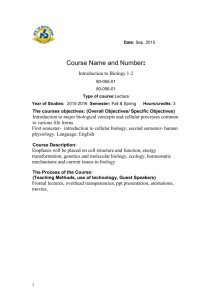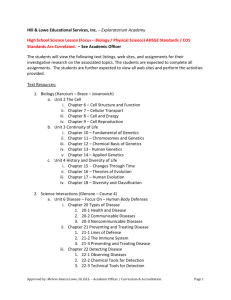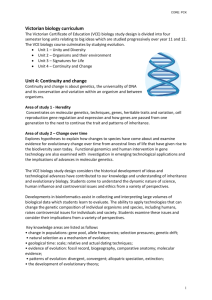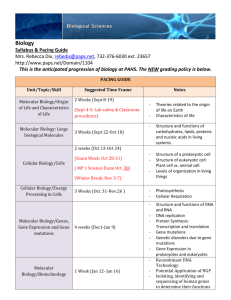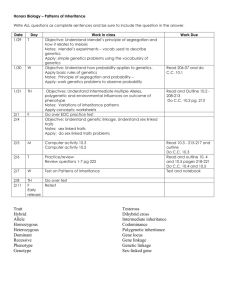BIO 1102 COURSE NAME: GENETICS & EVOLUTION COURSE
advertisement
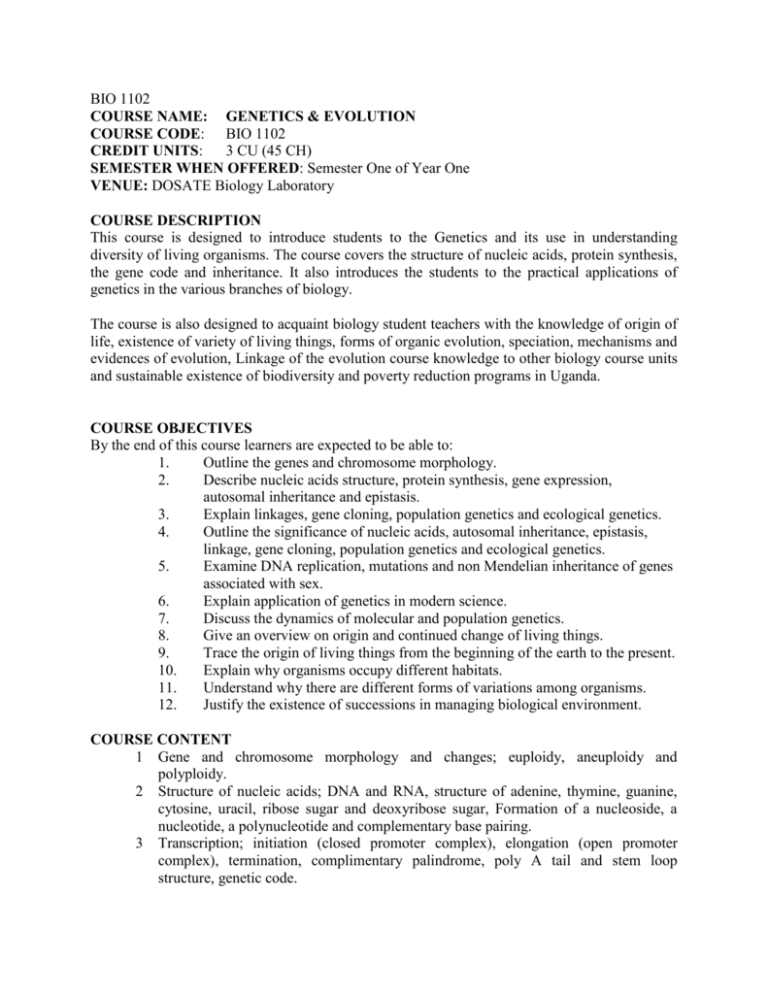
BIO 1102 COURSE NAME: GENETICS & EVOLUTION COURSE CODE: BIO 1102 CREDIT UNITS: 3 CU (45 CH) SEMESTER WHEN OFFERED: Semester One of Year One VENUE: DOSATE Biology Laboratory COURSE DESCRIPTION This course is designed to introduce students to the Genetics and its use in understanding diversity of living organisms. The course covers the structure of nucleic acids, protein synthesis, the gene code and inheritance. It also introduces the students to the practical applications of genetics in the various branches of biology. The course is also designed to acquaint biology student teachers with the knowledge of origin of life, existence of variety of living things, forms of organic evolution, speciation, mechanisms and evidences of evolution, Linkage of the evolution course knowledge to other biology course units and sustainable existence of biodiversity and poverty reduction programs in Uganda. COURSE OBJECTIVES By the end of this course learners are expected to be able to: 1. Outline the genes and chromosome morphology. 2. Describe nucleic acids structure, protein synthesis, gene expression, autosomal inheritance and epistasis. 3. Explain linkages, gene cloning, population genetics and ecological genetics. 4. Outline the significance of nucleic acids, autosomal inheritance, epistasis, linkage, gene cloning, population genetics and ecological genetics. 5. Examine DNA replication, mutations and non Mendelian inheritance of genes associated with sex. 6. Explain application of genetics in modern science. 7. Discuss the dynamics of molecular and population genetics. 8. Give an overview on origin and continued change of living things. 9. Trace the origin of living things from the beginning of the earth to the present. 10. Explain why organisms occupy different habitats. 11. Understand why there are different forms of variations among organisms. 12. Justify the existence of successions in managing biological environment. COURSE CONTENT 1 Gene and chromosome morphology and changes; euploidy, aneuploidy and polyploidy. 2 Structure of nucleic acids; DNA and RNA, structure of adenine, thymine, guanine, cytosine, uracil, ribose sugar and deoxyribose sugar, Formation of a nucleoside, a nucleotide, a polynucleotide and complementary base pairing. 3 Transcription; initiation (closed promoter complex), elongation (open promoter complex), termination, complimentary palindrome, poly A tail and stem loop structure, genetic code. 4 DNA replication; origins, replication fork, termination of DNA replication in eukaryotes and prokaryotes. 5 Autosomal inheritance and abnormalities; monohybrid cross, dihybrid cross, codominance and incomplete dominance. 6 Epistasis and gene interactions; types of epistasis, multiple alleles, linkage and lethal genes. 7 Chromosome and gene mutations; causes, classification, types, advantages and disadvantages 8 Sex linked and limited traits. 9 Cloning (gene and organism cloning). 10 Polygenic inheritance (punnett square or forked tree diagram). 11 Heterosis mid-parent and best-parent heterosis; inbreeding and out breeding depression. 12 Hardy-Weinberg principle; assumptions, deviations and causes of deviations 13 Molecular genetics; DNA and MRNA isolation, gene amplification-PCR and gene cloning, applications e.g. gene therapy-classical and non-classical. 14 Population genetics; natural selection, genetic drift-population/genetic bottle neck and founder effect, gene flow-barriers, genetic pollution and mitigation. 15 Ecological genetics; antibiotic resistance, peppered moth and other resistances. 16. Evolution and its link to biology; Theories of origin of Life: special creation, big bang, steady fast theory, cosmozoan theory, spontaneous generation and Solar system chemical theory. 17. Organic and chemical evolution; the idea of transmission of characters through and role of environment. 18. Population genetics and natural selection; Darwinism, transmission of characters, Gregory Mendel, Causes of variation - Hardy and Weinsberg principle and evolutionary lessons. 19. Factors that maintain transmission of characters; selection, population size, gene flow, gene frequency and genetic drift. 20. Mechanism of Speciation. 21. Isolation; geographical and reproductive ie pre and post zygotic barriers. 22. Evidences of evolution; palaeontology, continental drift, heritable changes in populations, embryological, physiology and anatomy. Systematics, biogeography, skin colour, culture, human skin hair, sickle cell anaemia, artificial selection, research and presentation of evolution topics classification in the plant and animal kingdom. Relationship between simple (primitive) and complex animals and plants (illustrations). MODE OF DELIVERY, EVALUATION AND ASSESSMENT (a)Mode of delivery: Lectures, laboratory practicals, discussions, seminars and individual research. (b) Assessment: i) A continuous assessment will be constituted by written assignments, practicals and course unit test(s). ii) The assessment will constitute 30% of the overall grade attained while the final University written examination will constitute 70%. READING LIST 1. Carl, P.S. Webster; I.P (1985): The cell New Jersey: Prentice Hall, Inc Engle wood cliffs. 2. Glenn and Suzzan Toole ( 1999 ): Understanding Biology,4th edition 3. Vernon L. A. (1995): Investing life on earth. England. Jones & Barlett publishers. 4. Campbell & Neil A (1993): Biology 3rd edition (1993), Benjamin/cummings publishing company inc. 5. Weaver, Hedrick (1997): Genetic WMC Broown Publishers, MC Graw-Hill Companies Inc. 6. Young J. Z (1981) The life of Vertebrates. Clarendo Press Oxford 7. Barnes, R.S.K; Calow, P and Olive, P.J.W (1993). The invertebrates: a new synthesis. 2nd ed. Blackwell Science. London. 8. Hickman, C.P; Roberts, L.S and Larson, A (1997). Biology of Animals. 7th ed. WCB McGraw-Hill 9. Cecie Starr (2000): Biology; Concepts and Applications. 4th Edition. U.S.A. 10. Raven P.H & Johnson G.B (1996): Biology. 4th Edition, Mm. C. Brown Publishers. 11. Burton S. Guttman (1999) Biology, WCB McGraw- Hill USA. 12. Helena Curtis (1979): Biology, 3rd Edition, Worth Publishers, Inc. New York 13. J. Simpkins & J.V. Williams (1989): Advanced Biology, 3rd Edition. Butter & Tanner Ltd, London. 14. Vernon L. Avila (1995): Biology; Investigating life on Earth, 2nd Edition, USA. 15. Green N.P.O et al (1995): Biological Science, 2nd Edition, Cambridge University press



